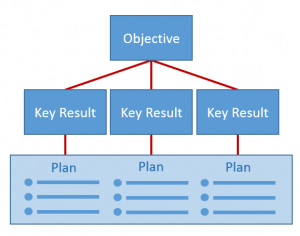Objectives and Key Results is a goal setting methodology that was originally developed at Intel and is now used by some of the world’s largest companies.
You might have heard about OKRs. Although they are not that well known in the UK, they are credited with being the key to success for a number of large companies and are widely used in the start up community. OKRs create focus and prioritization, aligning company, team and personal objectives to make sure everyone is working on the same goal.
Google’s John Doer is credited with popularizing OKRs after Google used them successfully to scale. A great way to get an overview of OKRs is to watch this video.
Companies using OKRs
The list of companies using OKRs is impressive; here’s a brief selection, there are many more!



What are the advantages of using this system? And how does it differ from standard performance management?
The key to their success is transparency. Everyone from the CEO down has their own OKRs which are shared across the whole company. People in the teams reporting into the senior teams will have their own OKRs which feed into top team goals. In this way, even in a large company, everyone feels a strong sense of alignment with the direction of the company overall. This is a proven way of increasing motivation and engagement for all employees.
As in life, as in business. We recommend starting as you mean to go on. If you start from Day One with the OKR system, even if there are only a handful of employees, you will find it much easier to scale as you grow and the goal setting process becomes natural.
People crave structure and clarity, this system gives it to them. In essence, OKRs are no different to many other standard performance management systems that you may have seen in businesses. They follow a standard cycle and involve some element of grading and judgment. However, where they differ is in two key aspects.
- They focus on business performance above all else. The development and evaluation of the individual employee, including most probably any variable remuneration will need to be dealt with in a separate conversation; but it will be strongly informed by the performance and what the employee needs to do to achieve great performance.
- The transparency. We’ve seen many businesses performance management systems over the years and its rare for the top team to share their goals and their gradings with all employees including junior ones. This may be a humbling experience for senior leaders, however, it sends a strong signal about the importance of learning together and the culture of your leadership.
OKRs are made up of two parts.
If you want to go ahead and get started with OKRs, its straightforward. Here’s what you need to know.
1) Objectives:
Objectives are goals. They tell everyone where to go and align with the vision and mission of a company. Its important to start from the top level goals of the business as a whole, then align each team’s OKRs with those top level goals. Depending on the size of your business, you may have several tiers of goals for each department and team, but these will all mesh with the ultimate objective of your main business goal whether that is profit, growth, or market share.
2) Key Results:
Each objective has about three Key Results. They indicate how the team will achieve the Objectives, and translate into actions.
This is where skill and judgment enters the picture. It is often delegated to individuals, teams or managers to set goals for their teams or themselves. Clearly there is a learning process, if the actions that the team were engaged in did not deliver the results in a period, it is up to the leaders to adjust their focus.
Here at joinair.com, we’ve been using this system since Day One and its a phenomenal tool to help us all keep on track and focussed.We really try to be objective, both in setting and grading OKRs. Its such a great discipline to get into! Even when we don’t hit our OKRs, which we often don’t, we are able to be honest about why not and strive to improve next time.
OKRs connect vision with actions
While OKRs drive activity, its important not to turn them into a To Do list or project management tool. Teams should develop their own processes for managing day to day priorities and tasks. Here is a great summary of the key differences between Objectives and Key Results.

Setting a timeline for OKRs
From the mission and vision, you derive your annual objectives.
Annual objectives split into quarterly objectives.
Finally, set the time when OKRs will be graded, results shared and learning discussed.
Grade Key Results
Only Key Results get graded. An Objective’s grade is the average of its Key Results. A good Key Result always enables objective grading. Objective grading is necessary for learning, but grading is never used for employee evaluation. Looking back at Rick Klau’s video, he explains where the interaction between key results and employee evaluation comes. Some key results are objectively harder than others, some are stretch and some are more akin to “business as usual”. Grading is an art not a science and it is the quality of the discussion between employee and their manager and the teams that enables the system to be used as a learning process.
Set objectives where 0.7 is good
Use a scale of 0 to 1 for grading. People should target 0.7 – 0.8 on average – if they are getting 1 consistently the objectives are not hard enough.
Some activities and businesses lend themselves more easily to the OKR system. Clearly in a growth or change environment it’s relatively simple to set and use OKRs. They may not be as suitable for process based or functional support activities, although, with skill, they can still be highly effective in these roles too.
Our Recommendations
1: Set OKRs quarterly or annually
A quarter and a year are timeframes in which you really can achieve something. The same timeframes are often used to evaluate companies.
2: Aim for 3 objectives with 3 KR each
5 objectives with 4 key results each is your maximum. Otherwise it’s hard to have focus on what really matters.
3: Make OKRs challenging
Research shows that people who set challenging targets achieve more. Expect to get 70% – 80% in the grading, not consistent 100%.
4: Make KR’s number based
Numbers create objective evaluation and a learning process.
5: Review regularly and transparently
Review the objectives monthly or weekly. Make objectives public for the whole business to see.
OKRs will without doubt help you lead and grow your business. And most importantly, they are a fantastic tool for motivating your employees. You will also need to talk to your teams about their individual development. For more on this, go to this article.